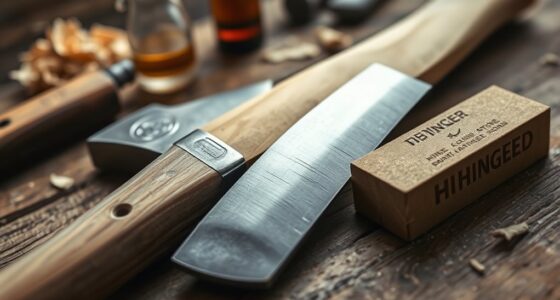To guarantee safety when handling and storing chisels, always wear proper PPE like safety glasses, gloves, and dust masks. Grip the chisel firmly and keep hands away from the blade while controlling pressure carefully. Store chisels in a designated toolbox or on racks with blade covers, keeping them dry and sharp. Regularly inspect tools for damage to prevent accidents. If you continue, you’ll discover even more essential safety tips to keep your workspace secure.
Key Takeaways
- Store chisels in a designated toolbox or on a rack with protective blade covers.
- Always handle chisels with a firm grip, keeping hands away from the cutting edge.
- Use sharp, well-maintained chisels to ensure safe, efficient work and prevent slips.
- Keep chisels dry and clean to prevent rust and maintain blade integrity.
- Follow safety guidelines, including wearing PPE and striking accurately to avoid accidents.

Have you ever considered how indispensable proper safety measures are when working with chisels? Handling these sharp tools requires more than just skill; it demands a commitment to safety that can prevent injuries and guarantee your work remains precise. One of the most important steps is always wearing the right Personal Protective Equipment (PPE). Safety glasses or goggles protect your eyes from flying chips or shards, which are common when you’re striking or carving. Wearing sturdy gloves can help safeguard your hands from accidental slips, but be cautious to choose gloves that don’t compromise your grip or control. Additionally, a dust mask might be necessary if you’re working with materials that produce fine particles, preventing inhalation of harmful dust. Proper handling techniques are equally essential. Always grip the chisel firmly but comfortably, ensuring you have full control over its movement. Keep your hands away from the cutting edge to avoid accidental cuts or punctures. When striking the chisel with a mallet or hammer, aim carefully and strike accurately to prevent the tool from slipping or bouncing unpredictably. Never force a chisel into a material; instead, use steady, controlled pressure, which minimizes the risk of slipping or damaging the tool. Make sure your workspace is well-lit and free of clutter, so you can focus entirely on your task without distractions or hazards. Proper storage of chisels is often overlooked but is fundamental for safety and maintaining their condition. When not in use, store chisels in a designated toolbox or on a rack with protective covers over the blades. This prevents accidental cuts when reaching into drawers or grabbing tools and keeps the blades from dulling or becoming damaged. Keep your chisels dry and clean to avoid rust or corrosion, which can weaken the blade and compromise safety. Regularly inspect your tools for any signs of damage or dullness, and sharpen or replace them as needed. A dull chisel can slip more easily, increasing the risk of injury, so maintaining sharp edges is an essential safety practice. Additionally, understanding chisel safety guidelines can significantly reduce the risk of accidents during your projects.
Frequently Asked Questions
How Often Should Chisels Be Inspected for Damage?
You should inspect your chisels for damage before each use to guarantee safety. Regular chisel maintenance and inspection frequency are vital to catch any cracks, chips, or wear early. Skipping inspections can lead to accidents or tool failure. Make it a habit to check your chisels often, especially after heavy use or if you notice any changes in performance. Proper care keeps your chisels safe and effective.
What Is the Best Way to Transport Chisels Safely?
When transporting chisels, always wear protective gear like gloves and safety glasses to prevent injuries. Use secure packaging, such as a toolbox with individual slots or padded containers, to keep chisels from moving and causing damage or harm. Guarantee the chisels are clean and dry before packing. Handle with care, avoiding dropping or jostling, and always carry them with the sharp edge pointed away from your body for added safety.
Can Chisels Be Stored in a Toolbox With Other Tools?
Think of your toolbox as a treasure chest—properly organized, it guards your tools like precious gems. Yes, you can store chisels with other tools, but make sure they’re in protective storage containers or securely laid out to prevent damage and injury. Proper toolbox organization keeps chisels safe from knocking, dulling, or accidental harm, ensuring they stay sharp and ready for use whenever you need them.
Are There Specific Safety Gloves Recommended for Chisel Handling?
Yes, for chisel handling, you should wear gloves made from durable materials like leather or reinforced rubber to protect your hands from sharp edges and potential slips. Look for gloves that meet safety standards such as ANSI or EN configurations. These gloves provide a good grip and cut resistance, ensuring your safety during chiseling tasks. Always choose gloves that fit well and allow dexterity for precise control.
How Should Damaged or Dull Chisels Be Disposed Of?
Think of damaged or dull chisels as worn-out tools in a well-loved orchestra; they no longer produce harmony and need to be retired. You should recycle chisels to prevent accidents, and dispose of damaged chisel disposal safely by wrapping sharp edges and taking them to a proper disposal facility. Never leave them in the workspace. Proper disposal guarantees safety for everyone and promotes responsible recycling practices.
Conclusion
Remember, handling chisels is like dancing with a sharp partner—you need focus, respect, and the right moves. Store them safely, like precious gems tucked away in a treasure chest, to keep your tools and fingers safe. When you practice chisel safety, you’re not just protecting your hands; you’re guarding your craftsmanship and turning each project into a masterpiece. Stay sharp, stay safe, and let your tools work with you, not against you.









